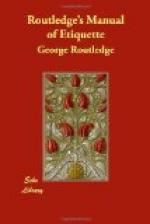The bridegroom stands at the right hand of the bride. The father stands just behind her, so as to be in readiness to give her hand at the proper moment to the bridegroom. The principal bridesmaid stands on the left of the bride, ready to take off the bride’s glove, which she keeps as a perquisite and prize of her office.
It was ordered by the old Rubrics that the woman, if a widow, should have her hand covered when presented by father or friend to the priest for marriage; one of the many points by which the Church distinguished second marriages. A piece of silver and a piece of gold were also laid with the wedding ring upon the priest’s book (where the cross would be on the cover), in token of dower to the wife.
The words “I Will"
are to be pronounced distinctly and audibly by both parties, such being the all-important part of the ceremony as respects themselves: the public delivery, before the priest, by the father of his daughter to the bridegroom, being an evidence of his assent; the silence which follows the inquiry for “cause or just impediment” testifying that of society in general; and the “I will” being the declaration of the bride and bridegroom that they are voluntary parties to their holy union in marriage.
The words “Honour and Obey"
must also be distinctly spoken by the bride. They constitute an essential part of the obligation and contract of matrimony on her part. It may not be amiss here to inform our fair readers that on the marriage of our gracious Sovereign Queen Victoria to H.R.H. the late lamented Prince Albert, her Majesty carefully and most judiciously emphasised these words, thereby manifesting that though a Queen in station, yet in her wedded and private life she sought no exemption from this obligation, and in this respect placed herself on the same level with the humblest village matron in her dominions.
This obedience on the part of the wife, concerning which there is oftentimes much serious questioning among ladies old and young, while yet unmarried, is thus finely defined by Jeremy Taylor:—“It is a voluntary cession that is required; such a cession as must be without coercion and violence on his part, but upon fair inducements and reasonableness in the thing, and out of love and honour on her part. When God commands us to love Him, He means we shall obey Him. ’This is love, that ye keep my commandments; and if ye love me,’ says the Lord, ‘keep my commandments.’ Now as Christ is to the Church, so is man to the wife; and therefore obedience is the best instance of her love; for it proclaims her submission, her humility, her opinion of his wisdom, his pre-eminence in the family, the right of his privilege, and the injunction imposed by God upon her sex, that although in sorrow she bring forth children, yet with love and choice she should obey. The man’s authority is love, and the woman’s love is obedience. It is modesty to advance and highly to honour them who have honoured us by making us the companions of their dearest excellencies; for the woman that went before the man in the way of death, is commanded to follow him in the way of love; and that makes the society to be perfect, and the union profitable, and the harmony complete.”




